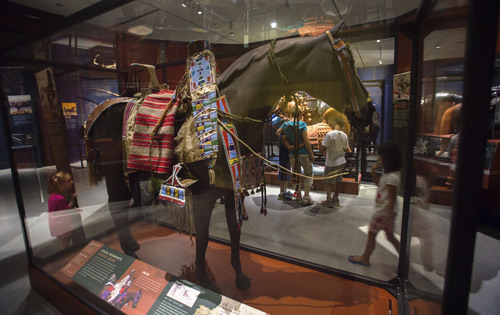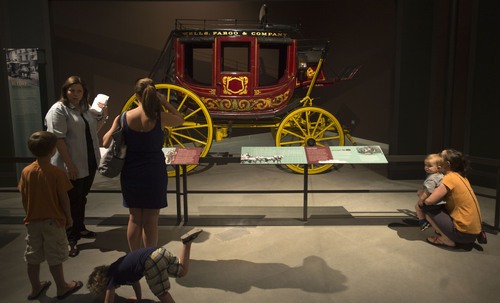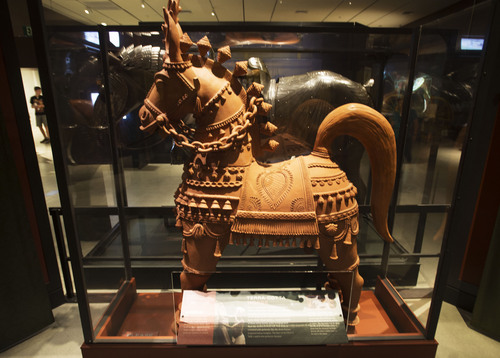Steve Griffin | The Salt Lake Tribune
Opening of "The Horse"--an exhibit from the American Museum of Natural History
Steve Griffin | The Salt Lake Tribune
Visitors look at a Wells Fargo and Company stage coach during the opening of "The H
Steve Griffin | The Salt Lake Tribune
Visitors look at a reproduction of horses painted in the Pech Merle Cave in southern Fra
Steve Griffin | The Salt Lake Tribune
Opening of "The Horseîóan exhibit from the American Museum of Natural History in
Steve Griffin | The Salt Lake Tribune
A terra cotta horse sculpture on display during the opening of "The Horseîóan exh
Steve Griffin | The Salt Lake Tribune
Opening of "The Horse"--an exhibit from the American Museum of Natural History
Steve Griffin | The Salt Lake Tribune
Visitors can use an interactive exhibit of a moving horse during the opening of "Th
Steve Griffin | The Salt Lake Tribune
Visitors look at a reproduction of horses painted in the Pech Merle Cave in southern Fra
Steve Griffin | The Salt Lake Tribune
Rodeo posters on display at the pening of "The Horse"--an exhibit from the Ame
Steve Griffin | The Salt Lake Tribune
Images of horses are projected onto The Canyon area of the Natural History Museum of Uta
Steve Griffin | The Salt Lake Tribune
Visitors look at life size skeletons of a human and a horse during the opening of "
Steve Griffin | The Salt Lake Tribune
A horse sculpture created by artist Deborah Butterfield is on display during the opening
Steve Griffin | The Salt Lake Tribune
Opening of "The Horse"--an exhibit from the American Museum of Natural History in New York City, in Salt Lake City, Utah Monday, July 21, 2014. The exhibit illuminates the story of how humans have shaped the horse and how the horse, in turn, has shaped us. The special exhibition includes cultural objects from around the world, a hand-painted diorama depicting the evolution of the horse and interactive displays that invite visitors to test their strength in horsepower, identify different breeds and look inside a life-size, moving horse.
Steve Griffin | The Salt Lake Tribune
Visitors look at a Wells Fargo and Company stage coach during the opening of "The Horse"--an exhibit from the American Museum of Natural History in New York City, in Salt Lake City, Utah Monday, July 21, 2014. The exhibit illuminates the story of how humans have shaped the horse and how the horse, in turn, has shaped us. The special exhibition includes cultural objects from around the world, a hand-painted diorama depicting the evolution of the horse and interactive displays that invite visitors to test their strength in horsepower, identify different breeds and look inside a life-size, moving horse.
Steve Griffin | The Salt Lake Tribune
Visitors look at a reproduction of horses painted in the Pech Merle Cave in southern France at least 16,000 years ago during the opening of "The Horseîóan exhibit from the American Museum of Natural History in New York City, in Salt Lake City, Utah Monday, July 21, 2014. Modern research suggests Ice Age artists took pigment into their mouths and blew it out of a bone tube creating the image. The exhibit illuminates the story of how humans have shaped the horse and how the horse, in turn, has shaped us. The special exhibition includes cultural objects from around the world, a hand-painted diorama depicting the evolution of the horse and interactive displays that invite visitors to test their strength in horsepower, identify different breeds and look inside a life-size, moving horse.
Steve Griffin | The Salt Lake Tribune
Opening of "The Horseîóan exhibit from the American Museum of Natural History in New York City, in Salt Lake City, Utah Monday, July 21, 2014. The exhibit illuminates the story of how humans have shaped the horse and how the horse, in turn, has shaped us. The special exhibition includes cultural objects from around the world, a hand-painted diorama depicting the evolution of the horse and interactive displays that invite visitors to test their strength in horsepower, identify different breeds and look inside a life-size, moving horse.
Steve Griffin | The Salt Lake Tribune
A terra cotta horse sculpture on display during the opening of "The Horseîóan exhibit from the American Museum of Natural History in New York City, in Salt Lake City, Utah Monday, July 21, 2014. The exhibit illuminates the story of how humans have shaped the horse and how the horse, in turn, has shaped us. The special exhibition includes cultural objects from around the world, a hand-painted diorama depicting the evolution of the horse and interactive displays that invite visitors to test their strength in horsepower, identify different breeds and look inside a life-size, moving horse.
Steve Griffin | The Salt Lake Tribune
Opening of "The Horse"--an exhibit from the American Museum of Natural History in New York City, in Salt Lake City, Utah Monday, July 21, 2014. The exhibit illuminates the story of how humans have shaped the horse and how the horse, in turn, has shaped us. The special exhibition includes cultural objects from around the world, a hand-painted diorama depicting the evolution of the horse and interactive displays that invite visitors to test their strength in horsepower, identify different breeds and look inside a life-size, moving horse.
Steve Griffin | The Salt Lake Tribune
Visitors can use an interactive exhibit of a moving horse during the opening of "The Horse"--an exhibit from the American Museum of Natural History in New York City, in Salt Lake City, Utah Monday, July 21, 2014. The exhibit illuminates the story of how humans have shaped the horse and how the horse, in turn, has shaped us. The special exhibition includes cultural objects from around the world, a hand-painted diorama depicting the evolution of the horse and interactive displays that invite visitors to test their strength in horsepower, identify different breeds and look inside a life-size, moving horse.
Steve Griffin | The Salt Lake Tribune
Visitors look at a reproduction of horses painted in the Pech Merle Cave in southern France at least 16,000 years ago during the opening of "The Horse"--an exhibit from the American Museum of Natural History in New York City, in Salt Lake City, Utah Monday, July 21, 2014. Modern research suggests Ice Age artists took pigment into their mouths and blew it out of a bone tube creating the image. The exhibit illuminates the story of how humans have shaped the horse and how the horse, in turn, has shaped us. The special exhibition includes cultural objects from around the world, a hand-painted diorama depicting the evolution of the horse and interactive displays that invite visitors to test their strength in horsepower, identify different breeds and look inside a life-size, moving horse.
Steve Griffin | The Salt Lake Tribune
Rodeo posters on display at the pening of "The Horse"--an exhibit from the American Museum of Natural History in New York City, in Salt Lake City, Utah Monday, July 21, 2014. The exhibit illuminates the story of how humans have shaped the horse and how the horse, in turn, has shaped us. The special exhibition includes cultural objects from around the world, a hand-painted diorama depicting the evolution of the horse and interactive displays that invite visitors to test their strength in horsepower, identify different breeds and look inside a life-size, moving horse.
Steve Griffin | The Salt Lake Tribune
Images of horses are projected onto The Canyon area of the Natural History Museum of Utah kicking of "The Horse"--an exhibit from the American Museum of Natural History in New York City, in Salt Lake City, Utah Monday, July 21, 2014. The exhibit illuminates the story of how humans have shaped the horse and how the horse, in turn, has shaped us. The special exhibition includes cultural objects from around the world, a hand-painted diorama depicting the evolution of the horse and interactive displays that invite visitors to test their strength in horsepower, identify different breeds and look inside a life-size, moving horse.
Steve Griffin | The Salt Lake Tribune
Visitors look at life size skeletons of a human and a horse during the opening of "The Horse"--an exhibit from the American Museum of Natural History in New York City, in Salt Lake City, Utah Monday, July 21, 2014. The exhibit illuminates the story of how humans have shaped the horse and how the horse, in turn, has shaped us. The special exhibition includes cultural objects from around the world, a hand-painted diorama depicting the evolution of the horse and interactive displays that invite visitors to test their strength in horsepower, identify different breeds and look inside a life-size, moving horse.
Steve Griffin | The Salt Lake Tribune
A horse sculpture created by artist Deborah Butterfield is on display during the opening of "The Horse"--an exhibit from the American Museum of Natural History in New York City, in Salt Lake City, Utah Monday, July 21, 2014. The exhibit illuminates the story of how humans have shaped the horse and how the horse, in turn, has shaped us. The special exhibition includes cultural objects from around the world, a hand-painted diorama depicting the evolution of the horse and interactive displays that invite visitors to test their strength in horsepower, identify different breeds and look inside a life-size, moving horse.

























